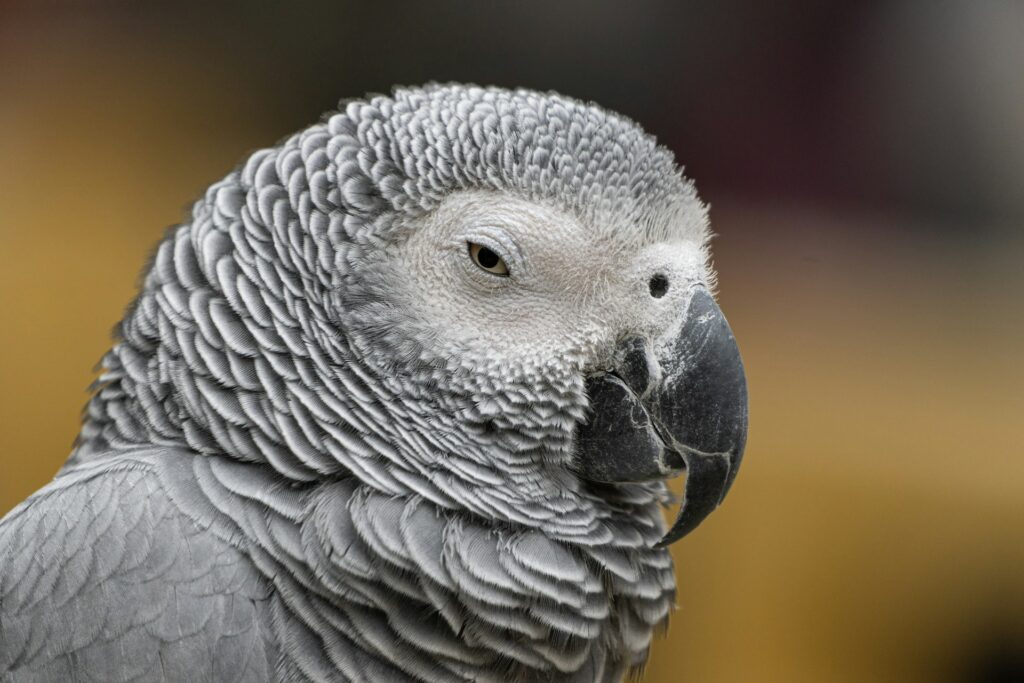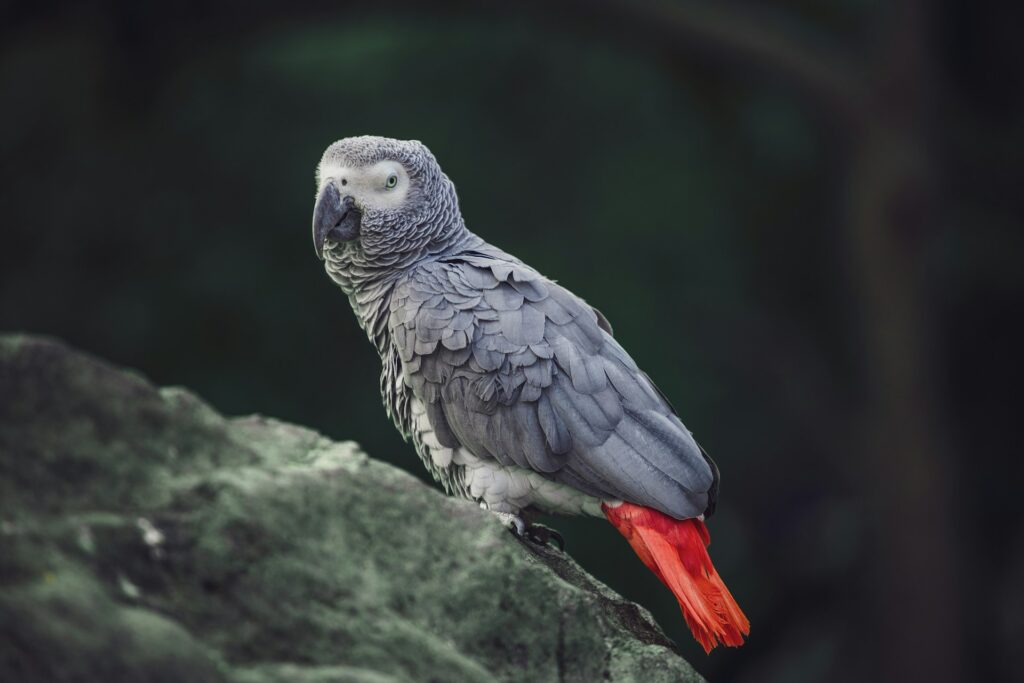The African Grey Parrots is a favorite among breeders due to its intelligence and beauty. Psittacus erithacus Congo African Grey is the most common species, whereas P. e. princeps is less common. It looks magnificent with its pale head, bright red tail feathers, and grey body. African Greys are typically shy, but with gentle handling from a young age, they can develop affection, though perhaps not as overtly as other parrot species.
The African Grey Parrot’s History
For millions of years, they have resided in the rainforests of Central and West Africa. To blend in better, they have evolved special abilities like intelligence, distinctive sounds, and colorful feathers. The genetic composition of African Grey Parrots indicates their resilience and environmental adaptability. Their genetic makeup demonstrates their hardiness and environmental adaptability. These amazing birds continue to attract people, whether it’s because of their long history in African woods or the increasing demand for them as pets across the world.
Types:
Two subspecies of African grey parrots are the Timneh and Congo.
Timneh African Grey:
The Timneh African grey costs more, is smaller, and is less well-liked. Timneh African greys are indigenous to the Ivory Coast, Guinea-Bissau, Sierra Leone, and Liberia. Their coloration is noticeably darker, which sets them apart. Timneh African greys cost between $1,500 and $4,000 when obtained from reliable breeders or pet stores, due to their restricted range and smaller population.
Congo African Grey:
In the pet trade, larger subspecies of Congo African grey parrots are also widely spread. The Congo African grey is found in the rainforests of Ivory Coast, Cameroon, and Congo in Central and West Africa. Because of their growing popularity, more individuals are breeding them, which means that there are more available, and their costs range from $500 to $2,800 depending on the breeder, age, and color.
Size and Age:
In the pet market, an African grey parrot’s age and size have an impact on its cost. As it costs less to care for younger birds until they reach adulthood, they typically cost less than adult birds. Because they are ready to form bonds and have created personalities, young adults (ages one to five) are more in demand and demand higher prices. Twenty- to fifty-year-old parrots may be less expensive because they may have health problems and live shorter lifetimes. Larger, fully grown African greys are also more in demand and cost more. Size and age are important factors for buyers to take into account when determining the worth and suitability of an African grey parrot.
Health:
Naturally, an African grey parrot in good health will cost more than one in poor health. Common health issues include pisittacosis and feather plucking. Not everyone is prepared for the costly medical bills that an ailing African grey parrot can face each month.
Housing and Supplies for African Grey Parrots
To avoid boredom, African Grey Parrots need daily care and interaction. Compared to other birds, African grey parrots are not the most affordable pets because proper care requires a significant financial investment.
Cages and Enclosures
When it comes to housing African Grey Parrots, selecting the right cage is paramount. As African Grey Parrots are curious and intelligent, choose a spacious cage with sturdy construction and locks designed especially for them.
Nutritious Diet
Proper nutrition is crucial for the health and well-being of African Grey Parrots. Bird food is specially formulated to meet the dietary needs of African Grey Parrots, providing a balanced blend of vitamins, minerals, and essential nutrients. From pelleted diets to seed mixes and fresh fruits and vegetables,.
Toys and Enrichment
They are highly intelligent birds that thrive on mental stimulation and enrichment. The selection of toys and accessories is designed to keep your bird entertained and engaged, with interactive puzzles, chew toys, and foraging opportunities to encourage natural behaviors and prevent boredom. From colorful hanging toys to treat-dispensing puzzles,.
Perches and Accessories
Creating a stimulating and comfortable environment for African Grey Parrots is essential for their overall well-being. The range of perches and accessories includes natural wood perches, rope perches, and grooming supplies to promote foot health and encourage physical activity.
Health and Wellness
Regular veterinary check-ups and proper hygiene are essential for keeping African Grey Parrots healthy and thriving. The selection of health and wellness products includes supplements, vitamins, and grooming supplies to support your bird’s immune system and overall health.
Quality of Food and Nutritional Supplements

- Investing in Quality: To protect the health and lifespan of African Grey Parrots, give top priority to premium commercial bird food blends and fresh produce.
- Supplemental Considerations: Investigate how nutritional supplements and treats can improve parrot’s diet while assessing the possible health benefits against the price tag.
African Grey Parrot Feeding Costs
Affordable foods may seem like a good deal for your budget, but it is not worth the possible medical expenses that come with feeding your child a low-quality, cheap diet. The most expensive and nutrient-dense foods for African grey parrots are $20 to $40 per month.They are herbivores and should eat seeds, nuts, and fruit. Ideally, you should feed your African greys nutritious food made with high-quality ingredients.
FAQ’S
1. What is the monthly cost of feeding an African Grey Parrot?
Depending on dietary preferences and portion sizes, providing an African Grey Parrot with high-quality food can cost anywhere from $20 to $40 per month on average.
2. Which foods are ideal for African Grey Parrots?
Commercial bird food blends, fresh fruits and vegetables, nuts, and seeds are among the nutrient-dense options that guarantee a well-balanced diet.
3. Can African Grey Parrots be fed homemade diets?
Even though homemade diets can be adjusted to meet dietary requirements, they might not contain all the nutrients that birds need, so it is important to speak with an avian veterinarian to make sure the food is adequate.
4. How often should I change the diet of my African Grey Parrot?
A balanced and varied diet should be the goal in order to promote optimal health, so it is best to gradually introduce dietary variety and observe your parrot’s reaction.
5. Are there economical ways to provide food for African Grey Parrots?
Even though a bird needs high-quality nutrition, control feeding costs without sacrificing its health by looking into cost-effective food options and buying in bulk.
Conclusion:
Understanding the variables affecting the cost of feeding African Grey Parrots is essential to giving them the best nutrition possible and ensuring their wellbeing. Feeding costs can be effectively controlled while maintaining the health and vitality of parrots through the use of responsible feeding practices, a strong focus on high-quality nutrition, and consideration of various factors such as species, age, and taste preferences.

